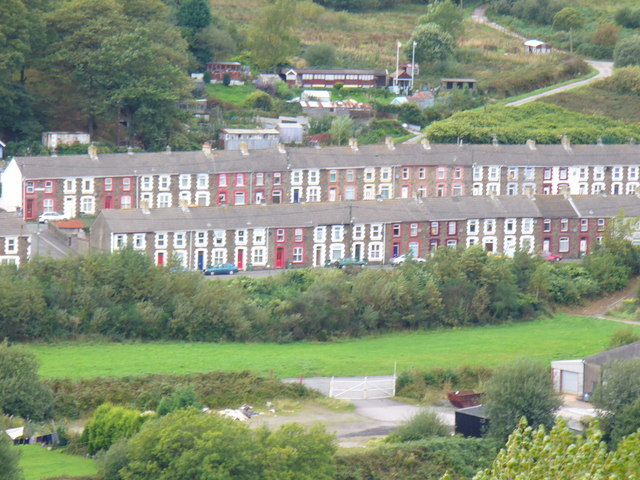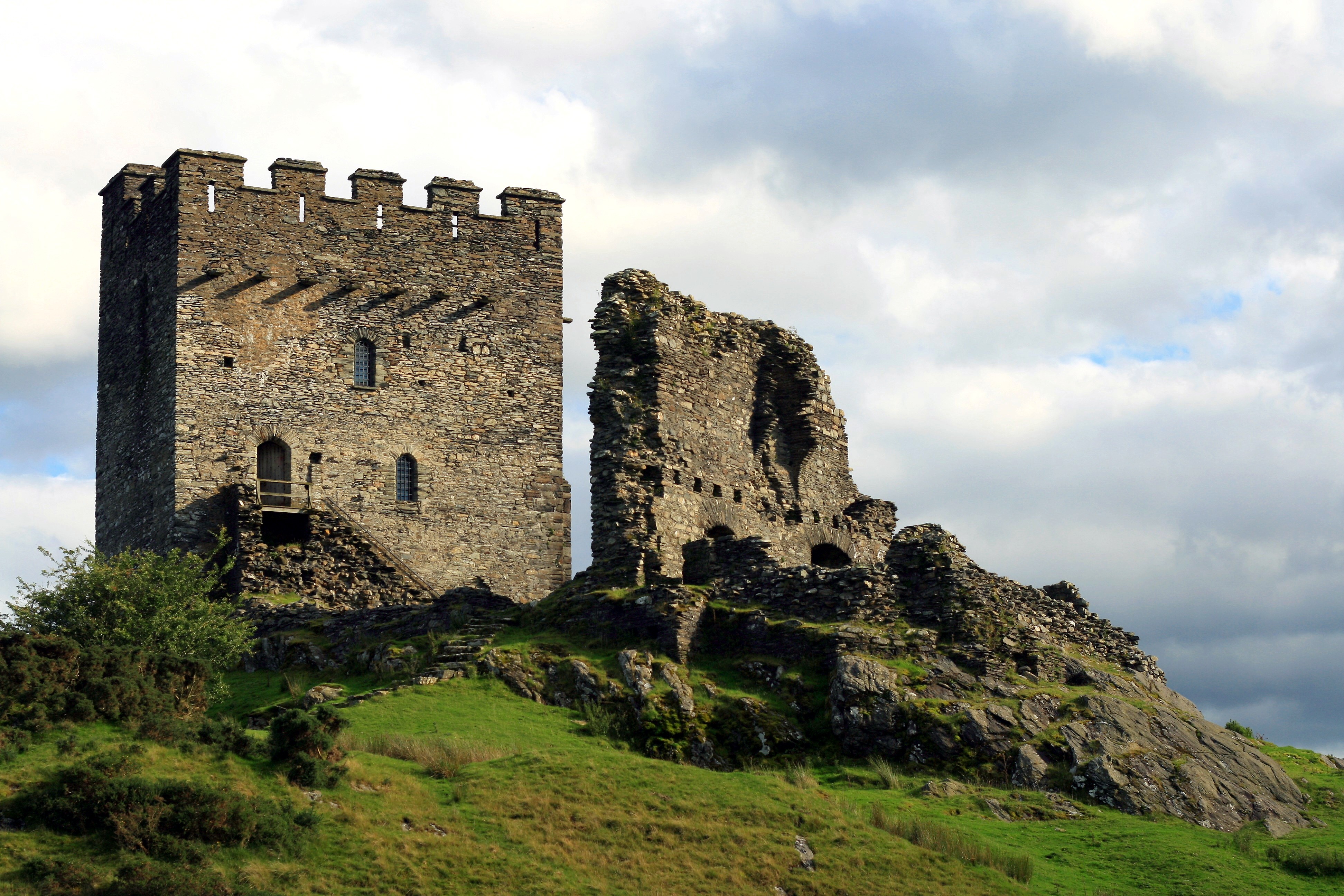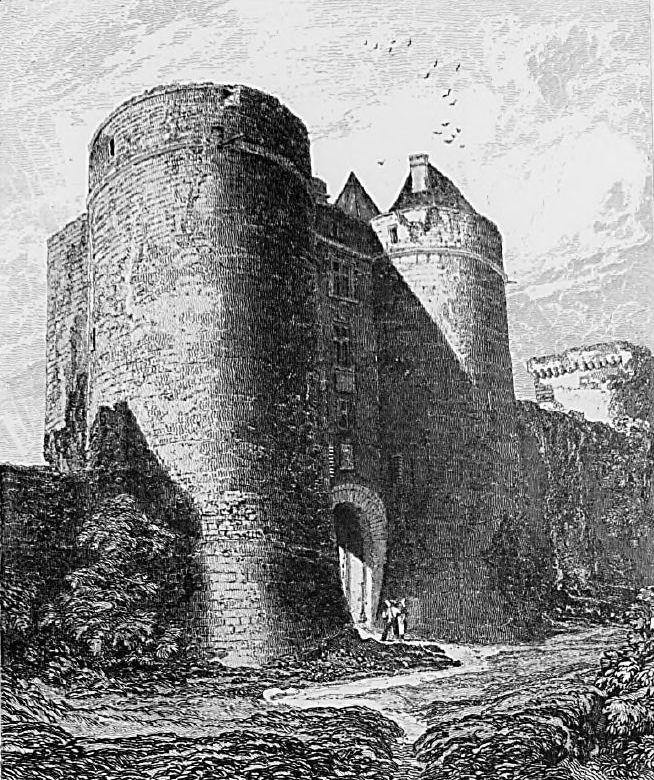|
Machen Castle
Castell Meredydd, also called Castell Machen, was a castle in Gwynllwg, Wales in the 13th century, long since ruined. Location The ruined castle, which is also called Machen, Maghay or Maghhay in historical documents, is in the community of Graig in the historic county of Monmouthshire and the modern authority of Newport. It has been described both as a timber castle and as a masonry castle. There are remains of masonry footings. The site is protected as a scheduled monument. Fortification Castell Meredydd is set on a ledge on a south-facing hillside. The castle consisted of a round tower about in diameter with walls about thick, and another large building about on two natural rocky mounds on the south side of an enclosure about from east to west, and from north to south. There was a latrine chute discharging from the tower keep down the cliff to the south. The knolls on which the keep and the hall stood are separated from the large bailey to the north by a ditch. The s ... [...More Info...] [...Related Items...] OR: [Wikipedia] [Google] [Baidu] |
Machen
Machen (from Welsh language, Welsh ' "place (of)" + ', a personal name) is a large village three miles east of Caerphilly, south Wales. It is situated in the Caerphilly (county borough), Caerphilly borough within the Historic counties of Wales, historic boundaries of Monmouthshire (historic), Monmouthshire. It neighbours Bedwas and Trethomas, and forms a Bedwas, Trethomas and Machen, council ward in conjunction with those communities. It lies on the Rhymney River. Mynydd Machen (Machen Mountain) provides a view over the village. It is possible to walk up to and along the top of the mountain, where a number of large boulders are present. Machen has a successful boules (petanque) team that are located at the rugby club. The team has had a team in the first Division of the boules in Gwent (BIG) league for the last 4 years. Industrial history Machen was a village rooted in the iron and coal industries stretching from the 17th Century. Though little trace remains, the village was ... [...More Info...] [...Related Items...] OR: [Wikipedia] [Google] [Baidu] |
Keep
A keep (from the Middle English ''kype'') is a type of fortified tower built within castles during the Middle Ages by European nobility. Scholars have debated the scope of the word ''keep'', but usually consider it to refer to large towers in castles that were fortified residences, used as a refuge of last resort should the rest of the castle fall to an adversary. The first keeps were made of timber and formed a key part of the motte-and-bailey castles that emerged in Normandy and Anjou during the 10th century; the design spread to England, south Italy and Sicily. As a result of the Norman invasion of 1066, use spread into Wales during the second half of the 11th century and into Ireland in the 1170s. The Anglo-Normans and French rulers began to build stone keeps during the 10th and 11th centuries; these included Norman keeps, with a square or rectangular design, and circular shell keeps. Stone keeps carried considerable political as well as military importance and could take up ... [...More Info...] [...Related Items...] OR: [Wikipedia] [Google] [Baidu] |
Dictionary Of Welsh Biography
The ''Dictionary of Welsh Biography'' (DWB) (also ''The Dictionary of Welsh Biography Down to 1940'' and ''The Dictionary of Welsh Biography, 1941 to 1970'') is a biographical dictionary of Welsh people who have made a significant contribution to Welsh life over seventeen centuries. It was first published in 1959, and is now maintained as a free online resource. Origins Robert Thomas Jenkins was assistant editor, then joint editor, of ' and its English-language counterpart, the ''Dictionary of Welsh Biography'', writing over 600 entries. His joint editor was John Edward Lloyd, but the ''Dictionary'' was not published until 1959, twelve years after his death. It is properly known as ''The Dictionary of Welsh Biography Down to 1940'', and its supplementary volume as ''The Dictionary of Welsh Biography, 1941 to 1970'' (2001). Originally published by the Honourable Society of Cymmrodorion, recent editions have been published by the University of Wales Press. ''The Dictionary of Wels ... [...More Info...] [...Related Items...] OR: [Wikipedia] [Google] [Baidu] |
Senghenydd
Senghenydd ( cy, Senghennydd, ) is a former mining town in the community of Aber Valley in South Wales, approximately four miles northwest of the town of Caerphilly. Historically within the county of Glamorgan, it is now situated in the county borough of Caerphilly. In the United Kingdom Census 2001, the population of the Aber Valley was 6,696. Toponym The name derives originally from the name Sangan + suffix ydd, probably meaning "the land or territory associated with Sangan". The suffix 'ydd' is often used in Welsh, following a personal name, to denote ownership, as in 'Meirionnydd' or ' Eifionydd'. Historically the name has appeared in a number of different forms, including: 'Seinhenit' (c. 1179), 'Seighenith' (c. 1194), 'Seynghenyth' (1271), 'Senghenyth' (1314), 'Seynthenneth' (1476), 'Seignhenith Suptus et Supra Cayach' (1578–84). Alternatively, the name may be a spelling variant, from 1326, of 'Seint Genith', from Saint Cenydd. The local church and school have ... [...More Info...] [...Related Items...] OR: [Wikipedia] [Google] [Baidu] |
Lord Of Glamorgan
The Lordship of Glamorgan was one of the most powerful and wealthy of the Welsh Marcher Lordships. The seat was Cardiff Castle. It was established by the conquest of Glamorgan from its native Welsh ruler, by the Anglo-Norman nobleman Robert FitzHamon, feudal baron of Gloucester, and his legendary followers the Twelve Knights of Glamorgan. The Anglo-Norman Lord of Glamorgan, like all Marcher lords, ruled his lands directly by his own law: thus he could, amongst other things, declare war, raise taxes, establish courts and markets and build castles as he wished, without reference to the Crown. These privileges were only lost under the Laws in Wales Acts 1535–1542. Though possessing many castles, the main seat of the Lordship was Cardiff Castle. First Creation *Robert Fitzhamon, the conqueror of Glamorgan (1093–1107) *Robert, 1st Earl of Gloucester (1118–1147) *William Fitz Robert, 2nd Earl of Gloucester (1147–1183) * Isabel, Countess of Gloucester (d. 1217) with: **John ... [...More Info...] [...Related Items...] OR: [Wikipedia] [Google] [Baidu] |
Gilbert De Clare, 7th Earl Of Gloucester
Gilbert de Clare, 6th Earl of Hertford, 7th Earl of Gloucester (2 September 1243 – 7 December 1295) was a powerful English noble. He was also known as "Red" Gilbert de Clare or "The Red Earl", probably because of his hair colour or fiery temper in battle. He held the Lordship of Glamorgan which was one of the most powerful and wealthy of the Welsh Marcher Lordships as well as over 200 English manors (172 in the Honor of Clare).Page, W. (1927) Parishes: Chilton. A History of the County of Buckingham: Volume 4. Ed. London, England: Victoria County History. Lineage Gilbert de Clare was born at Christchurch, Hampshire, the son of Richard de Clare, Earl of Hertford and Gloucester, and of Maud de Lacy, Countess of Lincoln, daughter of John de Lacy and Margaret de Quincy.Harrison, B.H. (2009). The Family Forest Descendants of Milesius of Spain for 84 Generations. The Family Forest National Treasure Edition. Kamuela, HI: Millicent Publishing Company, Inc. Gilbert inherited his fat ... [...More Info...] [...Related Items...] OR: [Wikipedia] [Google] [Baidu] |
Henry III Of England
Henry III (1 October 1207 – 16 November 1272), also known as Henry of Winchester, was King of England, Lord of Ireland, and Duke of Aquitaine from 1216 until his death in 1272. The son of King John and Isabella of Angoulême, Henry assumed the throne when he was only nine in the middle of the First Barons' War. Cardinal Guala Bicchieri declared the war against the rebel barons to be a religious crusade and Henry's forces, led by William Marshal, defeated the rebels at the battles of Lincoln and Sandwich in 1217. Henry promised to abide by the Great Charter of 1225, a later version of the 1215 '' Magna Carta'', which limited royal power and protected the rights of the major barons. His early rule was dominated first by Hubert de Burgh and then Peter des Roches, who re-established royal authority after the war. In 1230, the King attempted to reconquer the provinces of France that had once belonged to his father, but the invasion was a debacle. A revolt led by William ... [...More Info...] [...Related Items...] OR: [Wikipedia] [Google] [Baidu] |
Llywelyn The Great
Llywelyn the Great ( cy, Llywelyn Fawr, ; full name Llywelyn mab Iorwerth; c. 117311 April 1240) was a King of Gwynedd in north Wales and eventually " Prince of the Welsh" (in 1228) and "Prince of Wales" (in 1240). By a combination of war and diplomacy he dominated Wales for 45 years. During Llywelyn's childhood, Gwynedd was ruled by two of his uncles, who split the kingdom between them, following the death of Llywelyn's grandfather, Owain Gwynedd, in 1170. Llywelyn had a strong claim to be the legitimate ruler and began a campaign to win power at an early age. He was sole ruler of Gwynedd by 1200 and made a treaty with King John of England that year. Llywelyn's relations with John remained good for the next ten years. He married John's natural daughter Joan in 1205, and when John arrested Gwenwynwyn of Powys in 1208, Llywelyn took the opportunity to annex southern Powys. In 1210, relations deteriorated, and John invaded Gwynedd in 1211. Llywelyn was forced to seek terms and to ... [...More Info...] [...Related Items...] OR: [Wikipedia] [Google] [Baidu] |
Gilbert Marshal, 4th Earl Of Pembroke
Gilbert Marshal, 4th Earl of Pembroke (c. 1207 - 27 June 1241) was the third son of William Marshal, 1st Earl of Pembroke and Countess Isabel, the daughter of Richard son of Gilbert, earl of Striguil. Early life By calculating back from the date of his coming of age, Gilbert must have been the child with which his mother was pregnant during the insurrection against the Marshals in Leinster in 1207, and so was born in Ireland at the beginning of his father's political exile there. He would have been about twelve when his father died, and the Marshal biographer calls him then a 'clerk' which signifies he was then in minor orders. He was credited with the title 'magister' (master) in 1234 which he only would have acquired from a period of advanced study at a major school. The name of his private tutor is known to have been Master Henry of Hoo. In 1227 he was presented to Westminster abbey's wealthy living of Oakham in Rutland at which point he was still an acolyte one of the jun ... [...More Info...] [...Related Items...] OR: [Wikipedia] [Google] [Baidu] |
Striguil
Striguil or Strigoil is the name that was used from the 11th century until the late 14th century for the port and Norman castle of Chepstow, on the Welsh side of the River Wye which forms the boundary with England. The name was also applied to the Marcher lordship which controlled the area in the period between the Norman conquest and the formation of Monmouthshire under the Laws in Wales Acts 1535–1542. Origins of the name The name—which was spelled in various alternative forms, including Estrighoiel and Strigoiel in the Domesday Book—probably derives from the Welsh word ''ystraigyl'' meaning 'a bend in the river'. An alternative suggestion is that it derives from Welsh words ''ystre'', meaning boundary or dyke, and ''gwyl'', meaning watch or guard; a combined word ''ystregwyl'' could mean "well-guarded border (or dyke)", perhaps referring to the location's proximity to the southern end of Offa's Dyke. In the medieval period the town which grew up between the po ... [...More Info...] [...Related Items...] OR: [Wikipedia] [Google] [Baidu] |
Wales
Wales ( cy, Cymru ) is a Countries of the United Kingdom, country that is part of the United Kingdom. It is bordered by England to the Wales–England border, east, the Irish Sea to the north and west, the Celtic Sea to the south west and the Bristol Channel to the south. It had a population in 2021 of 3,107,500 and has a total area of . Wales has over of coastline and is largely mountainous with its higher peaks in the north and central areas, including Snowdon (), its highest summit. The country lies within the Temperateness, north temperate zone and has a changeable, maritime climate. The capital and largest city is Cardiff. Welsh national identity emerged among the Celtic Britons after the Roman withdrawal from Britain in the 5th century, and Wales was formed as a Kingdom of Wales, kingdom under Gruffydd ap Llywelyn in 1055. Wales is regarded as one of the Celtic nations. The Conquest of Wales by Edward I, conquest of Wales by Edward I of England was completed by 1283, th ... [...More Info...] [...Related Items...] OR: [Wikipedia] [Google] [Baidu] |
William Marshal, 1st Earl Of Pembroke
William Marshal, 1st Earl of Pembroke (1146 or 1147 – 14 May 1219), also called William the Marshal (Norman French: ', French: '), was an Anglo-Norman soldier and statesman. He served five English kings— Henry II, his sons the "Young King" Henry, Richard I, and John, and finally John's son Henry III. Knighted in 1166, he spent his younger years as a knight errant and a successful tournament competitor; Stephen Langton eulogised him as the "best knight that ever lived." In 1189, he became the ''de facto'' earl of Pembroke through his marriage to Isabel de Clare, though the title of earl was not officially granted until 1199 during the second creation of the Pembroke earldom. In 1216, he was appointed protector for the nine-year-old Henry III, and regent of the kingdom. Before him, his father's family held a hereditary title of Marshal to the king, which by his father's time had become recognised as a chief or master Marshalcy, involving management over other Marshals and ... [...More Info...] [...Related Items...] OR: [Wikipedia] [Google] [Baidu] |



.jpg)
